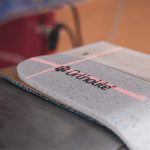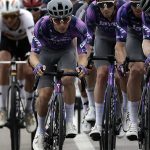Callaway Golf Company reported total sales for the fourth quarter ended Dec. 31, 2010 were $186 million, flat with the year-ago period. On a currency neutral basis, net sales would have been $181 million in 2010, a decrease of 3% compared to 2009.
Gross profit was $56 million, or 30% of net sales, compared to $58 million, or 31% of net sales, for 2009. Gross profit for 2010 and 2009 includes charges associated with the company's global operations strategy of $6 million and $2 million, respectively.
Operating expenses were $98 million, or 53% of net sales, compared to $87 million, or 47% of net sales in 2009. Operating expenses for 2010 include a $7.5 million non-cash charge related to Top-Flite intangible assets and $2 million of charges associated with the company's global operations strategy. There were no such charges in operating expenses in the fourth quarter of 2009.
The compay reported an operating loss of $42 million compared to an operating loss of $29 million in 2009. The operating loss for 2010 includes the $7.5 million non-cash charge related to Top-Flite intangible assets and charges in 2010 and 2009 associated with the company's Global Operations Strategy of $7 million and $2 million, respectively.
Regarding earnings results, the company reported a loss of 54 cents per share for 2010 and a loss of 29 cents per share for 2009.
- The loss per share for 2010 includes a loss of 7 cents per share related to the non-cash Top-Flite charges.
- The loss per share includes charges in 2010 and 2009 for the company's global operations strategy of 7 cents per share and 2 cents per share, respectively.
- Compared to 2009, the company's earnings were adversely affected in 2010 by an increase in other expense. This increase is attributable to mark-to-market charges of approximately 5 cents per share related to unfavorable changes in foreign currency.
- The company's earnings were adversely affected in 2010 by approximately 9 cents per share due to the impact of a lower effective tax benefit in the fourth quarter of 2010 compared to 2009.
“When the economic crisis hit the golf industry, we made the decision to weather the downturn with a balanced approach between tightly managing costs while continuing to invest in our business for the long-term,” said George Fellows, president and CEO. “And even though the golf industry has taken longer than we expected to fully recover, we still believe this was the correct approach. The investments we made, while adversely affecting 2009 and 2010 results, have already provided benefits and, more importantly, have set the foundation for greater returns in 2011 and beyond.”
“More specifically, in 2011, we expect to realize additional benefits from our investments in our emerging markets in China, Indonesia, and India, which collectively were up over 25% in 2010 compared to 2009, and in our soft goods and accessories category which was up 8% in 2010 compared to 2009,” continued Fellows. “We expect to realize further improvements in our gross margins primarily due to our continued investment in our global operations strategy, which yielded approximately $15 million in savings in 2010.
“In addition to these benefits from continued investment in our business, we are also encouraged by improving economic and market conditions,” explained Fellows. “The overall economic picture appears to be improving; the price discounting that was pervasive in 2009 was less in 2010; retail inventory levels are at reasonable levels; and we remain No. 1 or No. 2 in market share in almost all major product categories. While 2011 will ultimately depend on the degree to which consumers return to purchasing golf equipment, given these improving conditions and the expected continued improvement in our operational performance, we are cautiously optimistic as we begin the new golf season.”
“Although the delayed golf industry recovery, along with some non-operational charges, unfavorably impacted our financial results for the fourth quarter and full year 2010, our underlying operational performance improved significantly in 2010 as we realized additional benefits from our gross margin initiatives, investments in emerging markets, and cost management initiatives,” said Fellows. “And while our financial results are not where we expect them to be when the golf industry does fully recover, we are encouraged by the progress we have made this year even though the golf industry declined in the United States by approximately 2% and 12% in 2010 and 2009, respectively, and by approximately that much internationally as well. We expect that the improvements in gross margins this year and the positive trends in our full year operating results will continue into 2011.”
Full Year Results
Net sales for the full year ended Dec. 29 was $968 million, an increase of 2% compared to $951 million for the same period last year. On a currency neutral basis, net sales would have been $939 million in 2010, a decrease of 1% compared to 2009.
Gross profit for the year was $365 million, or 38% of net sales, compared to $344 million, or 36% of net sales, for 2009. Gross profit for 2010 and 2009 includes charges associated with the company's Global Operations Strategy of $13 million and $6 million, respectively.
Operating expenses for the year were $392 million, or 41% of net sales, compared to $374 million, or 39% of net sales, for 2009. Operating expenses for 2010 include (i) a $7.5 million non-cash charge related to a reduction in the recorded book value of certain non-amortizing intangible assets acquired as part of the 2003 Top-Flite acquisition and (ii) $2 million of charges associated with the Company's Global Operations Strategy. There were no such charges in operating expenses in 2009.
Operating loss for the year was $27 million compared to an operating loss of $31 million in 2009. The operating loss for 2010 includes (i) the $7.5 million non-cash Top-Flite intangible asset charge and (ii) charges in 2010 and 2009 associated with the company's Global Operations Strategy of $15 million and $6 million, respectively.
The company recored a loss of 46 cents per share for 2010 and a loss of 33 cents per share for 2009.
- The loss per share for 2010 includes a loss of $8 cents per share related to the non-cash Top-Flite intangible asset charges.
- The loss per share includes charges in 2010 and 2009 for the company's Global Operations Strategy of 14 cents per share and 6 cents per share, respectively.
- Compared to 2009, the company's earnings were adversely affected in 2010 by an increase in other expense. This increase is attributable to mark-to-market charges of approximately 11 cents per share related to unfavorable changes in foreign currency.
- The company's preferred stock adversely affected the company's earnings by approximately 16 cents per share in 2010 as compared to 9 cents per share in 2009 as the preferred stock was not issued until June of 2009.















